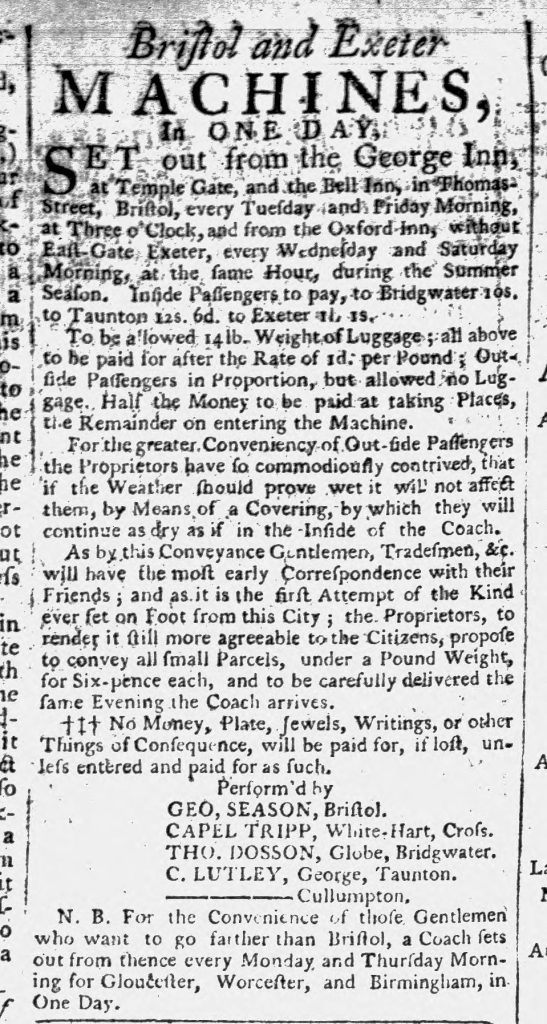Henry Dosson (1808-1870) currier; Harriet Bryant Dosson nee Nicholls (1812-1875) his wife; Sarah Hellier Young nee Dosson (1811-1897) his sister
Henry Dosson was a currier, or leather worker, in Bridgwater. Although he was born in Whitechapel, London, both Henry and his wife Harriet had generations of Bridgwater ancestors. The Dosson family were innkeepers, victuallers and wine and brandy merchants in Bridgwater as early as 1754. Further investigation revealed that the Dosson family had been going back and forth between Bridgwater and London for at least a generation before Henry was born. Descendants of the extended Dosson family by the 19th century included wine and spirit merchants, victuallers and cheesemongers in both London and Bridgwater. Along with the Bryant, Holloway and Hellier families, they formed a network of Bridgwater drapers, victuallers and liquor merchants who intermarried and who had property and business interests in both cities.
Henry Dosson’s family continued in business in Bridgwater into the 20th century as Nicholls & Co Drapers, Cornhill; Dosson Brothers, High Street, tailors and outfitters; and the Fore Street Clothing Company, tailors and outfitters.
The search for the Dosson family grew out of the biography of Mrs Mary Richards nee Dosson, who referred to her father’s will and the inheritance he had left her in her own will. The Dosson family do appear in some historic documents but are hard to find. They are often missing from the parish registers because for generations they belonged to non-conformist congregations. They can be unrecognizable in archives and indexes because the surname Dosson can be spelt in so many ways, for instance Dasson, Dusson, Dorson, Dowson and Dawson. Dosson is used throughout in this biography for clarity.
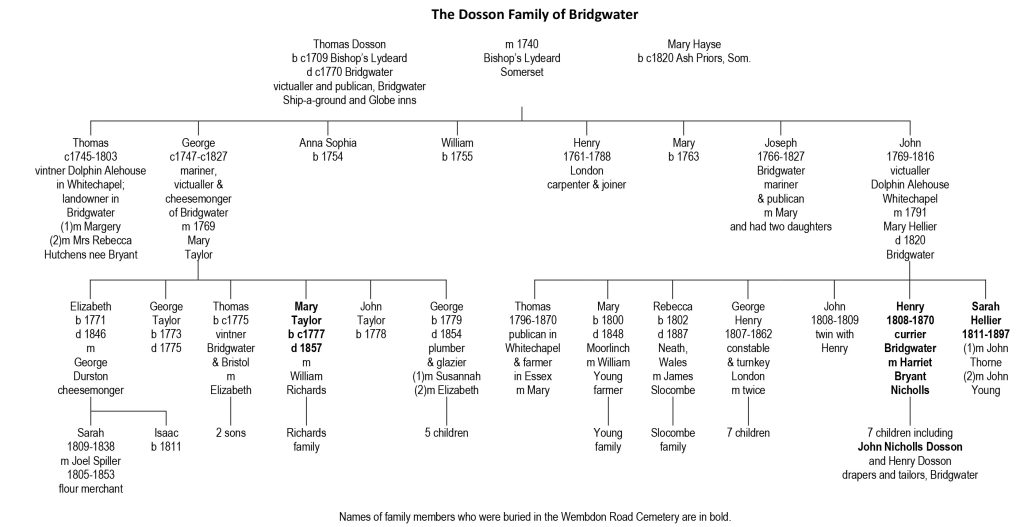
Thomas Dosson (c1709-1770) and the Globe Inn, Eastover.
Thomas was probably the son of villagers from Bishops Lydeard, near Taunton.[1] There is a marriage for a Thomas Dosson to Mary Hayse in May 1740. They were close enough to Taunton and Bridgwater for the markets, the annual fairs and to learn of other opportunities.
Bridgwater was an exciting place for a young couple. As innkeepers Thomas, Mary and their staff served food and drink to Bridgwater townsfolk, mariners and travelers for many years. Thomas was the innkeeper of the Ship-a-ground on a 1754 list of Bridgwater voters.[2] He may have had a second pub and other business interests as he was innkeeper of the Globe in May 1765 when a stagecoach service from Bristol to Exeter was advertised.[3] Although Bridgwater was a busy port, some people preferred to stay on dry land, even if it meant a long, bone-shaking journey and the risk of being robbed by highwaymen.
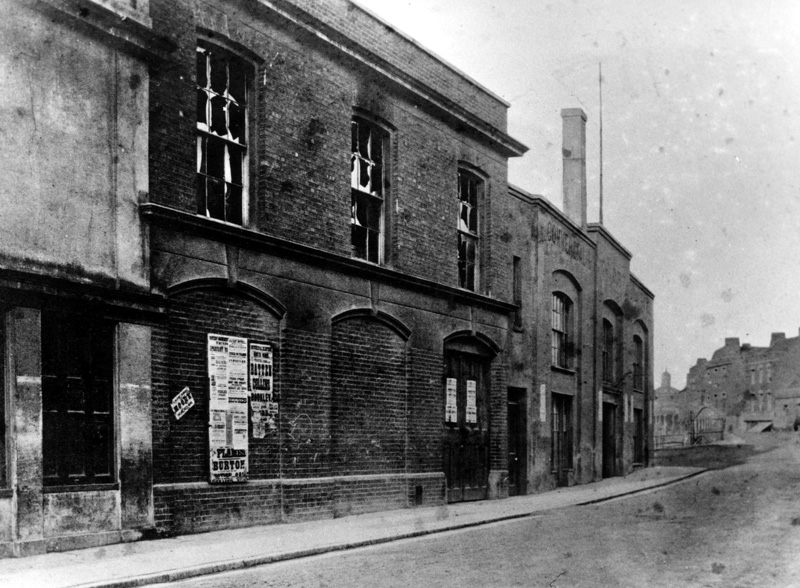
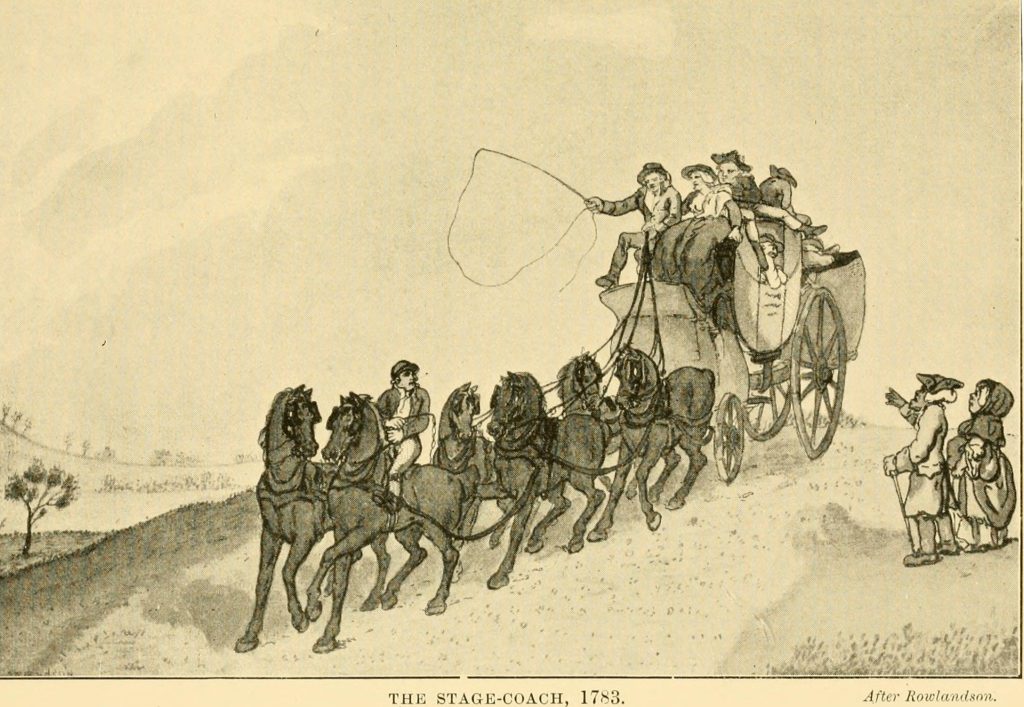
Above: Stagecoach and Mail in Days of Yore. Harper, C.G. Wikimedia Commons. In this era coaches travelled at around 5 miles per hour and took three or four days to reach London via Glastonbury, Wells, Frome and Andover. The roads were often bad and it was not uncommon for a coach to lose a wheel or overturn.
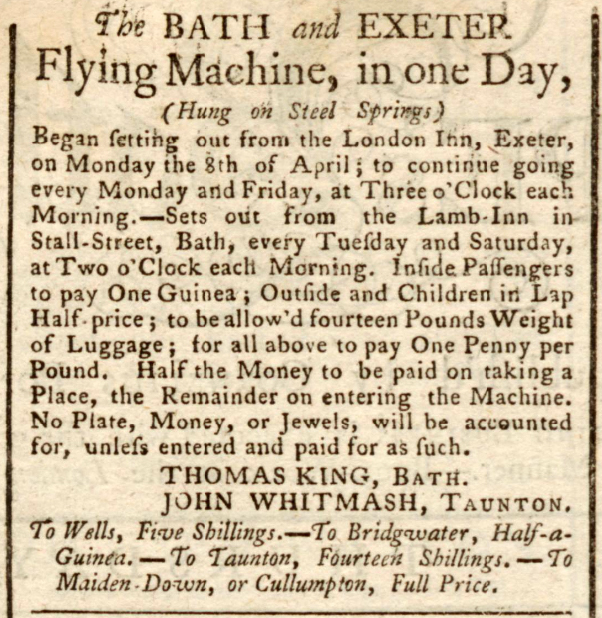
This stagecoach service went from Bridgwater to Bath but was in competition with Thomas Dosson and his associates on the Bridgwater to Exeter route. The roads were muddy and often impassable in winter, thus the one day service in summer only.
Left: Sherborne Mercury 13 May 1765
A fast stagecoach service relied on coaching inns at intervals of around ten to fifteen miles along the route so that fresh horses could be harnessed. Stops should last only twenty minutes, but might stretch into days if delayed by accidents or bad weather. The innkeeper benefited from the regular customers and for payment for providing horses. Thomas Dosson was one of four innkeepers named:
- George Season of the George, Temple Gate, Bristol,
- Capel Tripp of the White Hart, Cross, Somerset
- Thomas Dosson of the Globe, Bridgwater and
- Christopher Lutley of the George Inn, Taunton.
Capel Tripp (1719-1777) from Shipham, Somerset, was an especially interesting business associate. Cross was a hamlet on the old turnpike road to Bristol. The A38 now follows a similar route. Cross is about fifteen miles north of Bridgwater and Shipham is a couple of miles further on. He was an ambitious man. In 1758 Capel was a candidate in the election of the coroner for Cheddar, Somerset, but narrowly lost. It was described as “the greatest contest here for Coroner ever known in this county.”[4] In 1775 Capel Tripp or his son of the same name was a victualler at 1 Temple Gate, Bristol. Twenty years after the coach service was advertised, Capel’s daughter Phoebe married Josias Bryant, a Bridgwater currier and brother of Edward Bryant, a close friend of Thomas and Rebecca Dosson.
Thomas Dosson died in 1770, which is only known because his widow Mary was taken to court twice in Bridgwater in November and December 1770 to resolve alleged debts of a total of £150.[5] Thomas and Mary probably worshipped in non-conformist churches as the records of baptisms and burials for this family have not always survived.[6] As far as known, their children were:
- Thomas Dosson (c1745-1803) vintner, who went to London.
- George Dosson (c1747-c1827) victualler and cheesemonger of Bridgwater
- Anna Sophia Dosson (born 1754)
- William Dosson (born 1755)
- Henry Dosson (c1761-1788) apprenticed to a London joiner and died in London.
- Mary Dosson (born 1763)
- Joseph Dosson (1766-1827) mariner of Bridgwater and a half-brother of Thomas junior. He married and had two daughters baptised in Bridgwater by the Presbyterian minister.[7] In 1806 Joseph was an innkeeper in Bridgwater.
- John Dosson (c1769-1816) victualler and innkeeper in London
Thomas Dosson (c1745-1803), vintner of Whitechapel and Bridgwater
It was Thomas junior who went to London and made enough money to change the lives of his extended family as well as his own.
Thomas was probably apprenticed to his father at the Globe until he was about twenty. All that time he had heard mariners tell of their adventures and stagecoaches left the Globe for exciting places. Thomas left Bridgwater most likely with the blessing of his parents and with the essential letters of introduction to family, church and business contacts. It was not unusual for the son of a merchant to go to London to learn more about business.[8] However his parents could not have predicted that he would marry a woman twenty or thirty years his senior.
Mrs Margery Horner, nee Fisher, was the wife of Frederick Horner, a victualler. He was the publican either of the Dolphin Alehouse in Whitechapel Road or of another inn nearby. The Dolphin was not far from the busy docks on the Thames in east London. Frederick died of a fever aged forty in 1765, leaving Margery with the children, the business and £400.[9] Whether Thomas was working at the Dolphin before or after Frederick died is not known, but either way a man who had been trained to run an inn would have been a godsend rather than Margery try to do the work all on her own. Barrels of beer were heavy and inevitably there would be uncooperative patrons from time to time.
Thomas Dosson, bachelor, and Margery Horner, widow, were married at St Mary’s parish church, Whitechapel, on Christmas Eve 1767.[10] Margery was forty at least and may have been fifty when they married. It was quite common for a young man to marry an older widow. It made practical sense because a widow would normally already own household goods such as furniture and linen. In this case, Margery could give Thomas a secure home and employment as well. Margery’s elder brother James Fisher was a successful baker in Whitechapel who may have offered Margery and Thomas financial support if they needed it. When he died in 1776, James left Margery £250. A married woman’s assets by law belonged to her husband.

Younger brother Henry Dosson, eight years old, soon joined Thomas in London and attended the Merchant Taylors’ School in the City of London. It seems a long way from home but perhaps there were family reasons for choosing that school and Thomas was nearby. Within a few years Henry was apprenticed to a carpenter and joiner in London.[11]
Thomas was now the victualler of the Dolphin and part of the Whitechapel business community. In July 1774 he and another man stood bail for a friend who was charged with causing a nuisance.[12] In September of the same year, Thomas Dosson, yeoman, was indicted with having a pavement in a poor state of repair in front of his four dwelling houses in High Street, Mile End New Town. Two justices of the peace certified that the pavement had been repaired.[13]
Mrs Margery Dosson died aged sixty-four in February 1779. Thomas was the publican of The Dolphin and he had begun a business as a wine and brandy merchant. It was essential to know the right people and so Thomas became a liveryman in the Vintner’s Company of London.[14] He also joined the Freemasons Unity Lodge, Whitechapel.
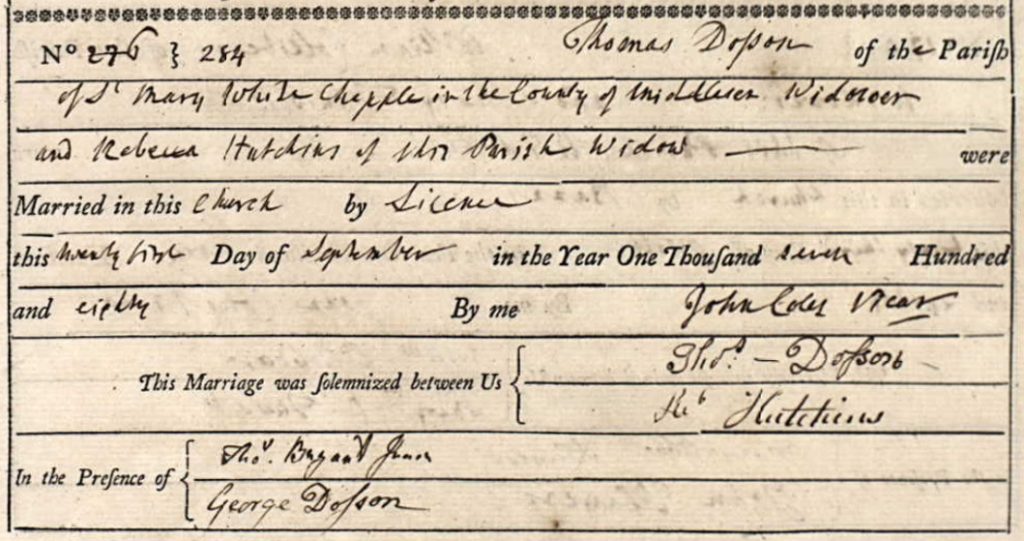
Thomas Dosson married Rebecca Hutchins in 1780. His brother George was a witness.
Thomas Bryant junior, the other witness, was possibly Rebecca’s brother.
Thomas returned to Bridgwater in September 1780 to marry another widow, Mrs Rebecca Hutchins nee Bryant (1742-1842). Rebecca also married her first husband, Thomas Hutchins, in Bridgwater so we can assume that she was Bridgwater born and bred. Thomas Dosson did not have any children of his own, but he was now a stepfather to Sarah Hutchins, 5, and Richard Hutchins, 18 months. Thomas took Rebecca and the children back to The Dolphin where they lived for the next few years.
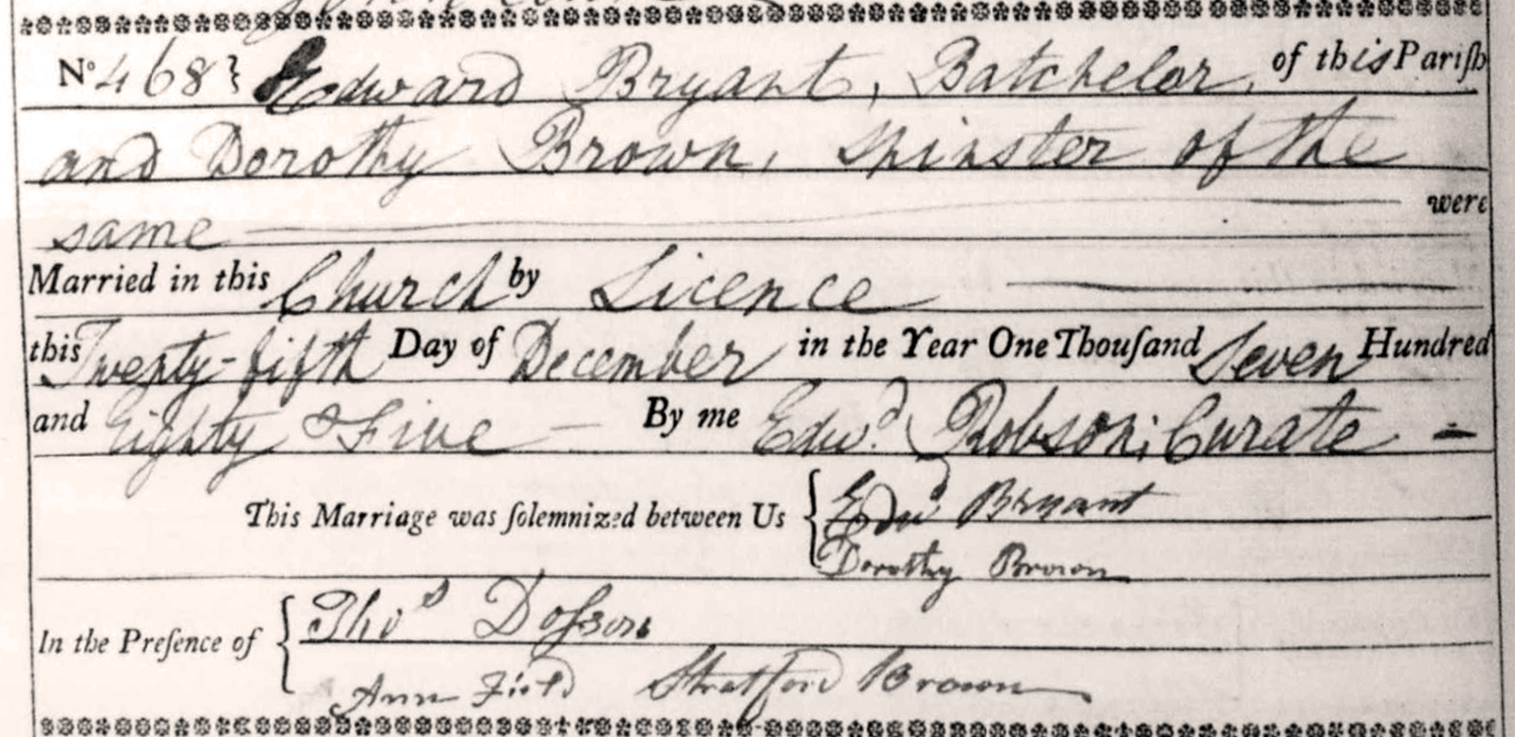
Thomas Dosson’s signature as a witness matches his signature in 1780 (see above).
On Christmas Day, Edward Bryant (c1758-1838) of Bridgwater married Dorothy Brown at St Mary’s parish church Whitechapel. Thomas Dosson and Stratford Brown were both witnesses. It is very likely that Edward was a nephew of Rebecca and that knowing he was single, she found a bride for him. On the marriage licence Edward stated that he was a plumber. A couple of months later when Edward and Stratford both followed the example of Thomas and joined the Freemasons at Whitechapel, Edward was a victualler of Whitechapel Road, so probably working at the Dolphin.[15] Stratford Brown was a butcher of Brick Lane two blocks from the Dolphin.
Thomas may have leased The Dolphin or left his brother John in charge so that he could leave London. In 1787 Thomas and Rebecca moved back to Bridgwater and in September of that year Thomas was appointed a constable of Eastover.[16]
Thomas had been a brandy and wine merchant in London and he continued in Bridgwater. He took on a new apprentice, his nephew Thomas Dosson (born 1775), son of George. Thomas and Rebecca became property owners in Bridgwater. The Borough recorded a lease of a property in Salmon Lane to Thomas and Rebecca in 1792, 1793 and 1794. In August 1795 the Borough was negotiating with Thomas for land by the Castle Tavern, possibly for the new Langport slip.

In 1793 the Dossons were to receive an annuity of £12 12s.[17] The following list of property owned by Thomas and Rebecca is from 1798:[18]
- their own home in Salmon Lane near the Bridgwater Infirmary.[19]

- a property in Eastover.
- part of the old Bridgwater Castle Manor. The castle itself was long gone and the land had changed hands many times. Thomas purchased “half the manor” from the Howe family.[20]
- a house in Friarn Street, “late Stambury’s”.[21] It was a comfortable family home, a couple of doors from the house of the Unitarian minister.
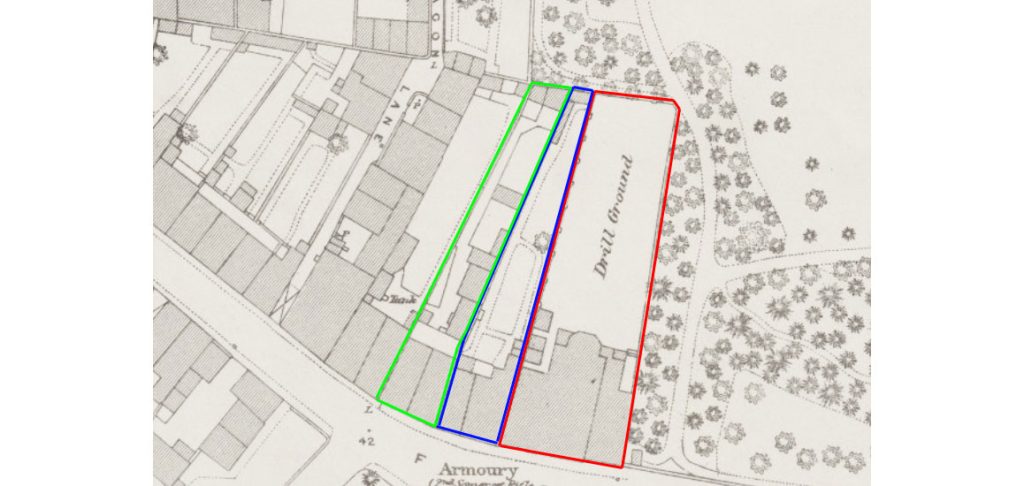
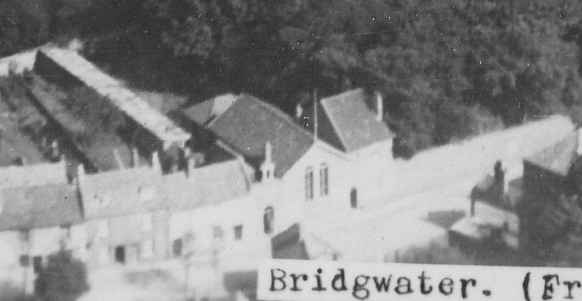
Any of the first three properties may have been an inn or an alehouse and incorporated the cellar for the wine and brandy business.
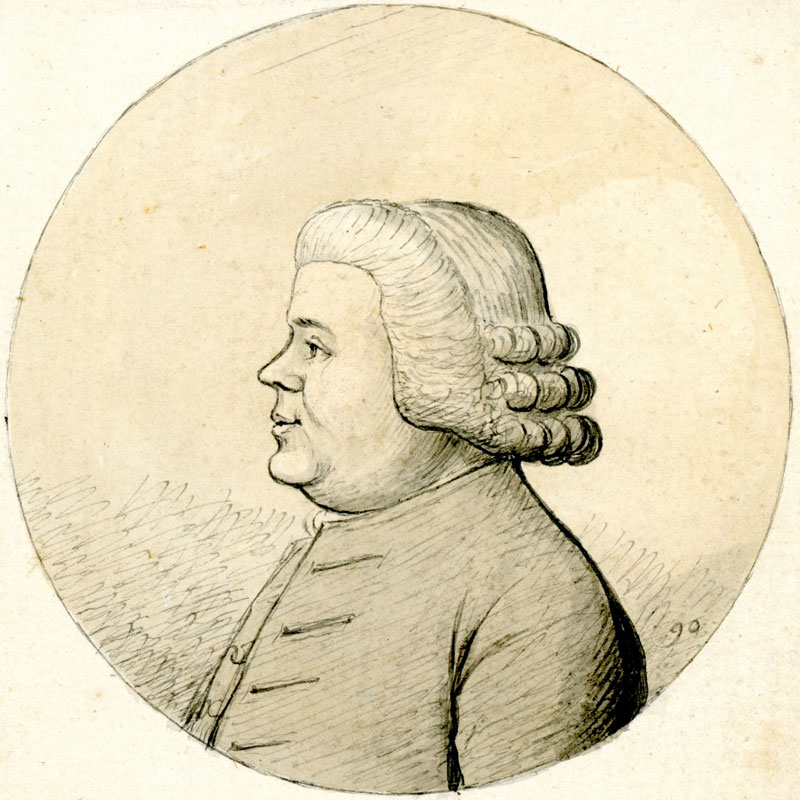
In 1790, Thomas, vintner, was sketched by John Chubb (1746-1818). John belonged to a merchant family in Bridgwater but is mostly remembered as an artist. He sketched and painted scenes of Bridgwater and also portraits of the townsfolk. [22]
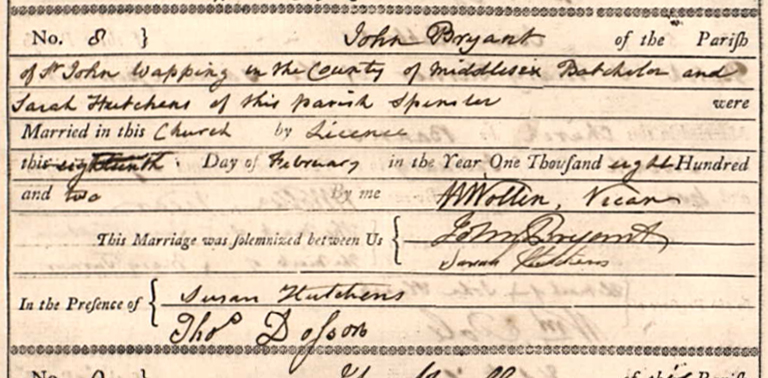
Thomas Dosson has signed the register as a witness.
Meanwhile in Whitechapel, John Bryant (1757-1850) was an anchorsmith and ironmonger with a shop and warehouse on a wharf at Wapping as early as 1794. John Bryant at Wapping and the Dosson family at Whitechapel were within walking distance of each other. In 1802 John travelled to Bridgwater to marry Sarah Hutchins, the daughter of Mrs Rebecca Dosson from her first marriage. Sarah’s stepfather Thomas Dosson and Susan Hutchins were the witnesses. Whether John Bryant was a friend or a relative is unknown, but Sarah clearly had parental approval. (Appendix 2)
In September 1802, the Borough negotiated a lease of a brewhouse by the Langport slip to Thomas, but he died before the lease could be executed. He was buried on 25th November 1803 aged 57 in St Mary’s churchyard, Bridgwater. Apart from his widow Rebecca, two of his brothers in particular were beneficiaries of his will. His brother George inherited property in Bridgwater and his brother John inherited the Dolphin Alehouse in Whitechapel.
Rebecca lived to the grand old age of 101. She spent her final years living in Monmouth Street, Bridgwater, with brandy merchant Thomas Hellier, his wife, his sister and three of his adult nieces who between them were Rebecca’s carers. It may have been the intention of Thomas that his younger brother John take over the Dolphin, and in return John and Molly would care for Rebecca. However they had both died before Rebecca and Thomas Hellier was both Molly’s brother and in the same wine and brandy business. (See Appendix 1.) Rebecca was buried in 1842 in Bridgwater.
George Dosson (c1747-c1827) victualler and cheesemonger of Bridgwater
While Thomas was in London, George became a mariner on the small, wooden sailing ships that took goods to and from Bridgwater and nearby ports. George may also have had voyages in the larger sailing ships that traded with Europe and North America, but this was long before any written records of merchant seamen were kept.
George married Mary Taylor by licence at St Mary’s Bridgwater on 14th December 1867. Unusually for the non-conformist Dosson family, George and Mary had six children all baptised in the parish church. Perhaps Mary insisted. George continued to risk his life by going to sea for at least another twenty years. If he owned or part-owned his ship and so had a share in the profits of trading, it was one of the few ways a man could get ahead. Each voyage was a high risk venture as apart from loss of life, losing a cargo could mean financial ruin. It was not unusual for a mariner to also own a pub which his wife would manage while he was at sea. In September 1799 George leased land in Eastover near the bridge, which may have been the Ship A-Ground Inn.
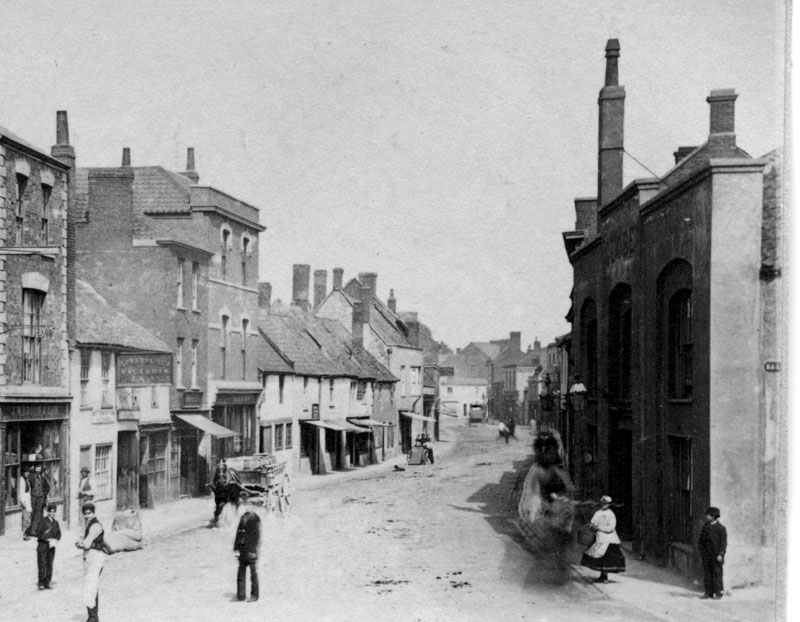
George retired as a mariner around the age of fifty and became a victualler and cheesemonger in Bridgwater. His eldest surviving son had been apprenticed to George’s elder brother Thomas, the next son was possibly working with George and the youngest boy was an apprentice plumber in Bridgwater. Then Thomas Dosson died and George inherited part of the Bridgwater Castle Manor, location and value not specified. George was the innkeeper of the Ship Aground in 1802.[23] Both George’s daughters were able to marry local merchants, which implied that George was able to offer a marriage settlement.
Surely life was now a little easier for George, but then he became involved in the 1807 general election. It was a time when MPs were wealthy landowners voted in by the small percentage of the population who were also landowners. Women did not have the vote and nor did the working man. Nationally election bribery and corruption were widespread. This time Bridgwater elected two MPs, George Pocock and William Thornton. They had offered voters bribes of up to £200 each. The history books record that the unsuccessful candidate, General Poulett, submitted a petition alleging that Pocock was guilty of bribery and corruption. However, the Journals of the House of Commons for January 1808 document that it was four Bridgwater men, George Dosson, John Haviland, William Mogg and James Saunders, who submitted the petition on the General’s behalf. Either way it made no difference to the outcome of the election. There is no record of what the four men received in return for outright accusing Pocock of offering “money, meat, drink, entertainment, presents, gifts and rewards” illegally and in contempt of the Parliament. They claimed that the returning officer accepted votes from supporters of Pocock and Thornton who had no right to vote. Nor is there any comment about what legal action George Pocock may have taken in response.
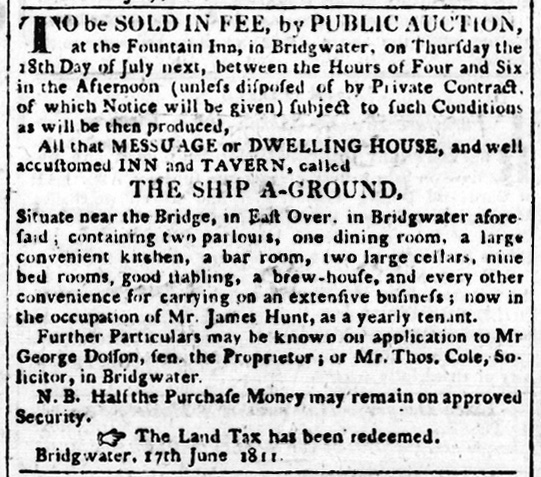
In 1811 George Dosson sold his share of the Bridgwater Castle Manor to William Mogg, corn and cheese factor and his fellow petitioner. He also sold the Ship Aground Inn.[24] George was now sixty-four and perhaps he wanted to pay some debts and then retire. He may have lived quietly in Bridgwater until about 1827, as suggested in his daughter Mary’s will. There is no record of the death of George nor of his wife Mary and presumably they were buried in the grounds of a non-conformist chapel. The six known children of George and Mary were:
- Elizabeth Dosson (1771-1846) married George Durston, grocer, tea dealer and cheesemonger of St Mary Street, Bridgwater. They had two children, a son Isaac and a daughter Sarah Taylor Durston (1809-1838). Sarah married Bridgwater flour merchant Joel Spiller (1805-1853), but she died of TB without having children.
- George Taylor Dosson (1773-1775)
- Thomas Dosson (born 1775) baptised in St James, Westminster; apprenticed to his Uncle Thomas Dosson, vintner.
- John Taylor Dosson (born 1778) probably unmarried and still living in Bridgwater in 1841.
- Mary Taylor Dosson (1778-1857) married Captain William Richards, master mariner, shipowner and merchant. (Please see her biography).
- George Dosson (1779-1854) plumber and glazier. He married twice and in 1851 he was a widower living in London with his son, another George Dosson, cheesemonger.
John Dosson (c1769-1816), victualler of Whitechapel
John was only a baby when his father died. In due course John joined elder brother Thomas in Whitechapel, London. John Dosson and Mary (Molly) Hellier were married there in 1791 and went on to raise several children. John was the publican of the Two Brewers, St Catherine’s Lane at St Katherine by the Tower, London. The Two Brewers was a very old pub with lots of history attached even in John’s time.[25] When Thomas died in 1803, John inherited all his brother’s property in Whitechapel.
John was the publican of the Dolphin Alehouse in Whitechapel Road for at least ten years. He was still living there with his family in 1812 with a land tax assessment of £28 2s 8d. John wrote his will in January 1814, by which time he was lodging at the Kingshead public house in Vauxhall Road, south of the Thames. John had already provided for his eldest son Thomas Dosson (1796-1870), who had taken over the Dolphin. John’s estate went to his wife Molly and the younger children. His executors were Molly and his friends Thomas Bryant Holloway[26] of Aldgate, London, and Thomas Hellier of Bridgwater (Molly’s brother).
The children of John and Molly Dosson were:
- Thomas Dosson (1796-1870) publican of the Dolphin and then farmer at Theydon Bois, Essex. His brother Henry came to live with him after the bankruptcy.
- Mary Dosson (1800-1848) married William Young, farmer of Moorlinch, Somerset.
- Rebecca Dosson (1802-1887) married James Slocombe and raised a family in Neath, Wales.
- George Henry Dosson (1807-1862) constable then turnkey at a debtor’s prison; married twice and retired to Bridgwater. He had seven children and has many descendants.
- Henry Dosson (1808-1870) twin, currier of St Mary Street, Bridgwater.
- John Dosson (1808-1809) twin
- Sarah Hellier Dosson (1811-1897) married twice and was widowed twice. Sarah spent her final years with her sister Rebecca in Wales. (Please scroll down for Sarah’s biography.)
Normally, there would be nothing further about John Dosson in the official records as there was no census in his lifetime and he steered clear of the courts. However one of his former employees, a man named Thomas Batt (born 1789), was in 1835 on the prison hulk Fortitude at Chatham, awaiting transportation. The Shoreditch Overseer of the Poor went to Chatham on 10th February 1835 and interviewed Batt about his former employment with the aim of saving the Shoreditch ratepayer the considerable expense of supporting Mrs Batt and her children. He needed to prove that Batt had never worked at the Dolphin. The diligent overseer interviewed anyone he could find who remembered the Dolphin, the Dosson family and their employees and then followed the clues they gave him to find the next witness. [27]
- Thomas Batt saith that when he was about 12 years of age, he hired himself as a yearly servant to Mr (believed to be this) Dawson then of the Dolphin Public House corner of Great Garden St in the parish of St Mary Whitechapel at £4 per annum and lived with and served his master there as such for 10 months.
- The overseer went to Whitechapel and spoke with John Miner, 60. He knew old Mr Dosson who kept the Dolphin. Mrs Brodie who now keeps the Dolphin is an aunt of young Dosson. His nephew Theophilus Cooper used to work at the Dolphin.
- Theophilus Cooper, 40, was living in Mile End New Town at the back of the Whitechapel workhouse. He lived as a servant with Batt at Dossons. Cooper was a weekly servant, but believes Batt to be a yearly servant. He knew Thomas Batt, a fellow servant at the Dolphin – was about 12 years of age then, never heard Batt say how he was hired weekly or yearly, was there before Batt and all the time he was there which was about two years or so and after Batt left. Cooper did the work that Batt was afterwards employed to do. Batt lodged in the Dolphin all the time. Daniel Cotton who now drives a Hackney coach in Whitechapel Road succeeded Batt, he stands at Mile End gate. Mr Dosson had several daughters, none known to Cooper. Brodie’s wife was Mrs Dosson’s sister. Mr Dosson is at Mrs Francis’s Alridge Essex, she keeps the White Hart Inn. George Dosson a brother at Whitechapel St prison. Mrs Brodie is dead. Mr Dosson keeps a large farm near Walthamstow.
- Mr Thomas Dosson, Abridge, Essex, says he has no present recollection of Batt living with his father at the Dolphin. He has some of his father’s books. Mr Dosson will look over them and send me a line by Thursday. Mr Dosson well recollects Daniel Cotton living with his father, he was with him several years. There was a barmaid, maiden name Catherine Phillips, lived many years with Mr Dosson’s father, she afterwards married. Mr Dosson doesn’t know her present name nor where she now resides. He heard of her 2 or 3 years ago.
- Archibald Brodie, Dolphin, 50 Whitechapel Road, keeps the house formerly kept by Dosson.[28]
- Mr Daniel Cotton, 2 Newcastle Place, Mile End Road, on Gate. Saith that he is about 36 years of age and when about 6 or 10 years of age he was hired as a yearly servant to Mr John Dosson of the Dolphin Public House, as a pot boy, don’t recollect the wages but hiring was yearly at yearly wages, lived there 3 or 4 years or more, don’t recollect Batt. There were in the Dosson family two sons George and Thomas and two daughters Jane and Ann.[29] (A pot boy in a pub collected the used beer pots for washing.)
- Mrs Catherine Vaughan, formerly Catherine Phillips, barmaid at the Dolphin, now resides at no 16 Avery Rd, Lower Grosvenor St, Bond St, says that she was a relation of old Mr Dosson who kept the Dolphin and lived with him there many years. She knew Daniel Cotton when he lived with Mr Dosson and it was Mr Dosson’s practice to hire his male and female servants by the year.
Henry Dosson (1808-1870) Currier of Bridgwater.
Henry and his twin brother John were born at the Dolphin Alehouse, Whitechapel, on 23rd October 1808 and were baptised in the parish church on 6th January 1809. John died when he was eight months old. Henry was seven when his father died.
Two adults proved very important to Henry’s future, his widowed mother Molly and her brother Thomas Hellier (c1775-1858), a wine and spirit merchant of Bridgwater. Molly moved back to Bridgwater and her family with the younger children. She still had her brother Thomas and her sister Jane Rowley living there. Thomas was a supporter of the Congregational Church in Bridgwater and was soon to be elected to the Town Council. There was another tragedy for Henry when his mother Molly died in 1820. Henry was now twelve and almost old enough to start work. Thomas Hellier would have had the contacts and the means to see that Henry learnt a trade and in due course would become a respected member of the business community.
Henry was apprenticed to a currier, or leather worker, of which there were at least two in Bridgwater. A tanner started with the fresh cow, pig and sheep hides and cleaned and preserved them by means of the tanning process. The currier purchased the tanned hides and first removed the last of the tanning fluid. He then stretched each hide to a uniform thickness and trimmed it. The leather could also be stained or dyed. The currier rubbed in beef tallow and cod liver oil to make the leather soft, supple and waterproof. Traditionally this was all done by hand and required significant physical strength. The currier sold the leather to shoemakers, glovemakers and saddlers.
Once Henry had finished his apprenticeship, he was free to marry, but he also had to find work as a journeyman currier. He married Harriet Bryant Nicholls, 18, of Bridgwater in Bristol in February 1831. Henry and Harriet had at least seven children, but in line with the Dosson family’s non-conformist beliefs, none were baptised in the parish church. Henry was a currier in Fore Street, Bridgwater, and eligible to vote in general elections in 1835, 1837 and 1841.[30] The family lived over the shop. Then in one tragic week at the end of March 1840, their three younger children, Mary Jane, 2, Harriet, 14 months, and baby Lucy Ann, 2 months, all died of pneumonia, one after the other. They were probably buried in the grounds of the Zion Chapel. How Henry and Harriet coped is not recorded, but almost certainly they would have been encouraged to find comfort in their religion. Doctors could do very little and in illness and grief people turned much more to church or chapel.
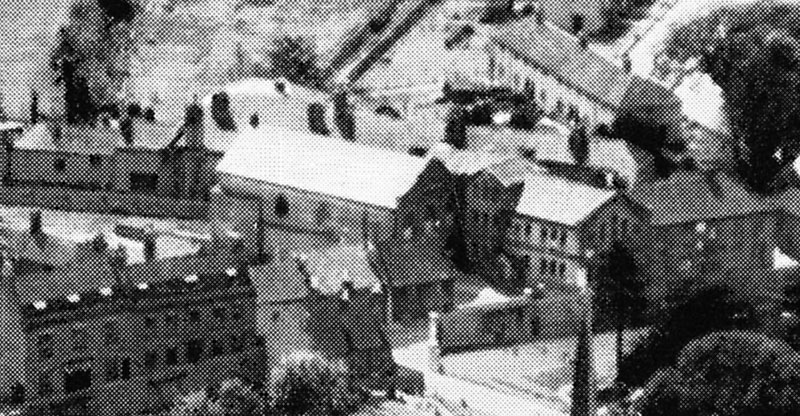
Henry continued in his trade as currier and the 1841 census lists Henry and Harriet living in St Mary Street, Bridgwater, with Sarah, 6, and one young maid. John, 7, was away from home. Harriet gave birth to another son and daughter in the following two years, but there was more bad news. Henry’s business was failing and in May and June 1842 he appeared in the bankruptcy court in Ilchester. He may even have been briefly in the debtor’s prison there. This is ironic considering his brother George, one year older, was at the time a constable and later the principal turnkey of the debtor’s prison at St Giles Cripplegate, London. The reasons why the business failed were not stated. There could have been too much competition from factories up north as the industrial revolution rolled on, plus the economic recession of the 1840s in rural areas was just beginning. Henry may have been disabled by illness or alcohol. There was no leniency in the courts for a man who was grief-stricken.
The outcome was that Henry left Bridgwater. His reputation was gone and there was no money with which to set up a new business anyway. Henry was 43 and still able to work. His eldest brother Thomas had a farm at Theyden Bois, Essex, and took him in. Presumably it was Thomas and other family members who paid Henry’s debts, thus securing his release from Ilchester.
Harriet and the children however remained in Bridgwater. Perhaps that was a condition set by his family or that Henry set himself, that he should allow Harriet and his sons to work in the Nicholls’ drapery business without the taint of bankruptcy.
Henry eventually found work as a currier in Glastonbury and lodged with a fellow currier and his family. Bridgwater and his wife and children were about fifteen miles away, so close enough to see them on special occasions. Henry died of a stroke at Glastonbury on 5th June 1870. His eldest son John, of Cornhill, Bridgwater, was present. Henry was buried in the Wembdon Road Cemetery.
Mrs Harriet Bryant Dosson (1812-1875) and her family
Harriet lived all her life in Bridgwater. Her father was John Nicholls, a master draper from Bradford in Wiltshire. Her mother was Sarah Tucker (born 1789), daughter of Nathaniel Tucker (1767-1804). Nathaniel was born in Stogursey but grew up in Cannington.[31] He was apprenticed to Richard Axford, a Bridgwater ironmonger. In due course Nathaniel became a master ironmonger and cutler with a property in Bridgwater “between the church and the bridge.” [32] Harriet was named Bryant after her maternal grandmother, Nathaniel Tucker’s wife, Sarah nee Bryant (born 1760). Sarah belonged to one of the several Bryant families in Bridgwater at that time. The Tucker children were born in Bridgwater and lived with their parents over the ironmonger’s shop.
The Nicholls family, including Harriet, would have lived over the draper’s shop at the same time as Henry Dosson was starting his career as a currier in Bridgwater, so it is easy to see how they could have met. They may also have attended the same church, but some of the Nicholls children were baptised in the parish church and Henry was more likely Congregational.
When Henry went bankrupt, Harriet naturally turned to her parents for help. Henry had been the breadwinner and Harriet couldn’t just go out to work because apart from her two elder children, she had a babe in arms and another on the way. In the 1851 census, Harriet’s occupation is described as housekeeper. She was living in Fore Street with her brothers Henry (a future mayor) and Alfred above their draper’s shop. Usually a woman moving back in with her family would be working in exchange for food and board and would not be paid wages. If she wanted something extra for herself, she would have to ask her father or brothers. Harriet’s son John, 17, was there too but Henry, 7, was at school at Wembdon. It was fortunate that there was money to pay his school fees. Sarah, 16, was elsewhere as she was old enough to be earning a wage. There were two draper’s apprentices, seven draper’s assistants and two housemaids also living under the same roof. It was a lot of staff for one shop, but perhaps the shop assistants included tailors and dressmakers.
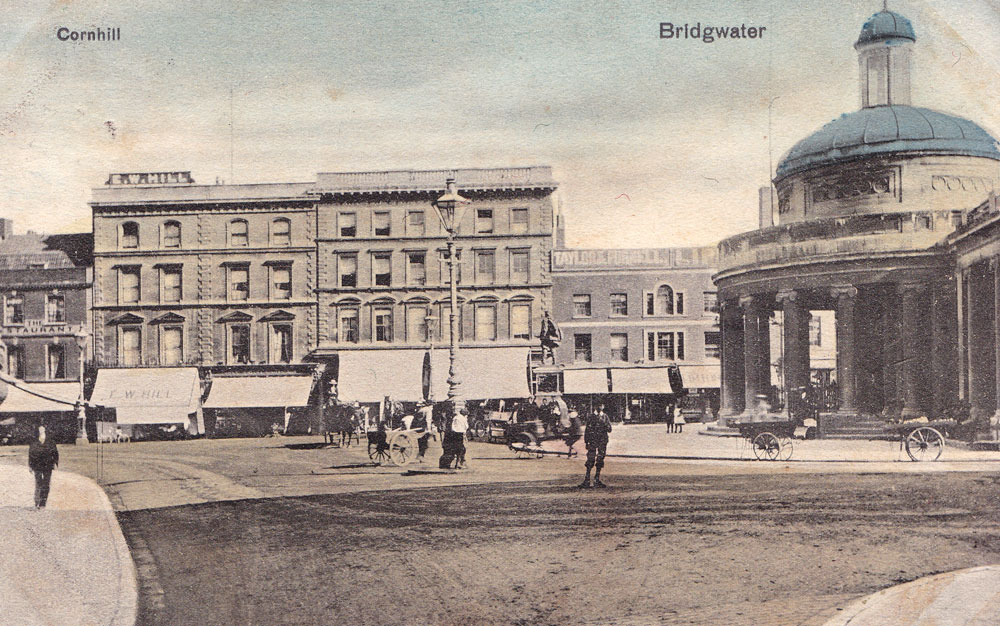
Nicholl’s drapers shop moved to Cornhill and in 1861 Harriet, still the housekeeper, had her three surviving children all living with her. John and Henry were learning the business as assistants and Sarah was a schoolmistress. This time there were another seventeen assistants and apprentices and three servants, all at the same address. Within a couple of years both John and Sarah had married and John opened his own draper’s shop in Bridgwater. Sarah married George McMichael, a Baptist minister, and they moved away.
Harriet retired to Alexandra Road, Wembdon, with her son Henry who had remained single. She died in August 1875. We don’t know if Harriet was reunited with her husband before he died, but they were buried together in the Wembdon Road Cemetery. The children of Henry and Harriet Dosson were:
- John Nicholls Dosson (1833-1927) draper, Bridgwater. (Please see his biography.)
- Sarah Hellier Dosson (1835-924) married George McMichael, Baptist minister.
- Mary Jane Dosson (1837-1840)
- Harriet Dosson (1839-1840)
- Lucy Ann Dosson (b&d 1840)
- Henry Dosson (1841-1906) draper, Bridgwater.
- Mary Jane Dosson (1843-1844)
Sarah Hellier Young nee Dosson (1811-1897)
Sarah was a younger sister of Henry Dosson the currier. Her parents were John Dosson and Molly (Mary) nee Hellier. Sarah was born in Lambeth, which is now in south London, but her father died only a few years later and her mother moved back to Bridgwater with the younger children. Sarah was nine when her mother died.
Sarah grew up in Bridgwater with her older siblings and living with her mother’s family, supervised by her Uncle Thomas Hellier. She attended school and probably the Congregational Zion Chapel. In 1834 she married John Thorne, painter, of Bridgwater. Nothing further is known of him. Sarah married again as a widow in 1846 to a much older man, John Young (1793-1857). He was the brother of her sister Mary’s husband. They married at St John’s parish church, Eastover, and the witnesses were Thomas and Sarah Hellier. John was a yeoman farmer of Sutton Mallet, a couple of miles east of Bridgwater. The 1851 census shows John, retired, and Sarah living in Sutton Mallet. There were no children.
John died in 1857 and Sarah went to live with her sister Rebecca, brother-in-law James Slocombe and their family in Neath, Wales. James was born in Bridgwater in about 1802 and was the foreman of a chemical works in Neath. He died in 1868.
Rebecca died in 1887 and in 1891, Sarah was living with or staying with Mrs Esther Dosson, 87, her daughter Sophia and her son Edwin in Bristol. All three women were widows. William Taylor Dosson (1801-1864), was the son of Thomas Dosson (b 1775), vintner of Bristol. This Thomas was a first cousin of Sarah (please see family tree chart.) William Taylor Dosson married Esther Corner in London and moved to Neath where he worked as a clockmaker. They raised a large family in Neath and would have been well-known to the Slocombe family and to Sarah. Esther died in 1892 which meant another move for Sarah. She returned to Bridgwater and was living in Friarn Street when she died on the 16th January 1897. Sarah was buried in the Wembdon Road Cemetery with her brother Henry Dosson and his wife Harriet.
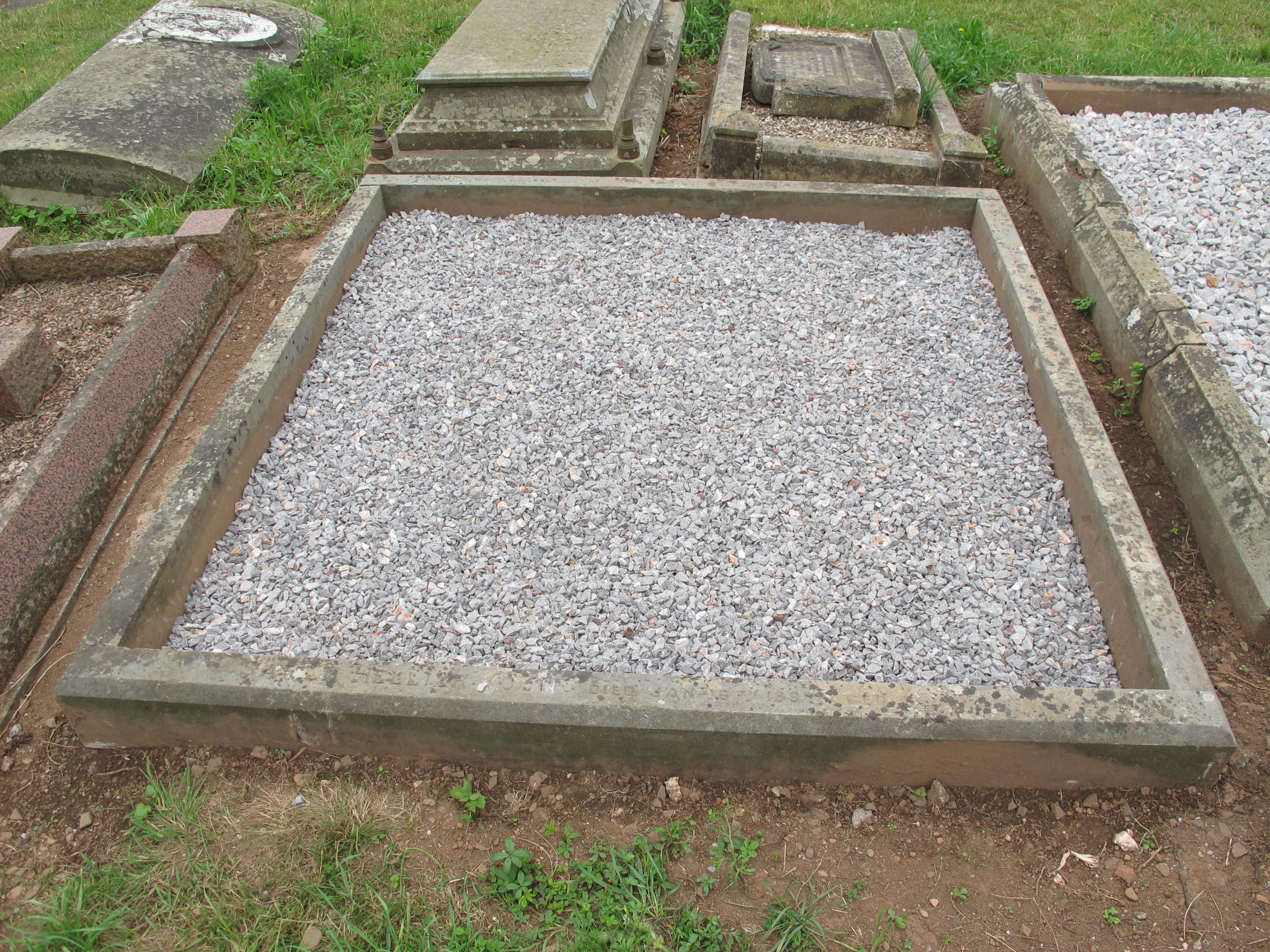
by Jillian Trethewey and Clare Spicer 11/8/2024
Sources:
Bridgwater Heritage Group website.
British Newspaper Archive.
Census records, directories, Freemasons’ records, parish registers and poll books.
Evans, Roger. The Book of Bridgwater. Halsgrove. Tiverton, Devon. 2006. On page 63 there is information about stagecoach travel.
Harper, Charles George. A Picturesque History of Coaching Chapman & Hall Ltd. London. 1903. Seen on the website of Internet Archive. Illustration: Stagecoach and mail in days of yore.
Journals of the House of Commons. 1808. Vol 63. Seen on Google Books. This volume includes the text of the petition of George Dosson et al and references to when it was tabled and discussed.
London Metropolitan Archives online catalogue.
Robinson, Charles John. A Register of the Scholars Admitted into Merchant Taylors’ School 1562-1874. Farncombe & Co. Lewes 1883. Seen on Google Books.
Sebborn, David. Thomas Dosson. The Friends and Associates of John Chubb. BWRAB 2004/1/84 - seen on the Bridgwater Heritage Group website.
Squibbs, Phillip J. Squibb’s History of Bridgwater. Phillimore. Chichester. 1982. Pages 60 and 61 – stagecoach travel.
Thorne, R. G. The History of Parliament. The House of Commons. 1790-1820. Boydell and Brewer 1986. Seen on the website of The History of Parliament Online. Bridgwater Borough.
Appendix 1
The Hellier Family of Bridgwater.
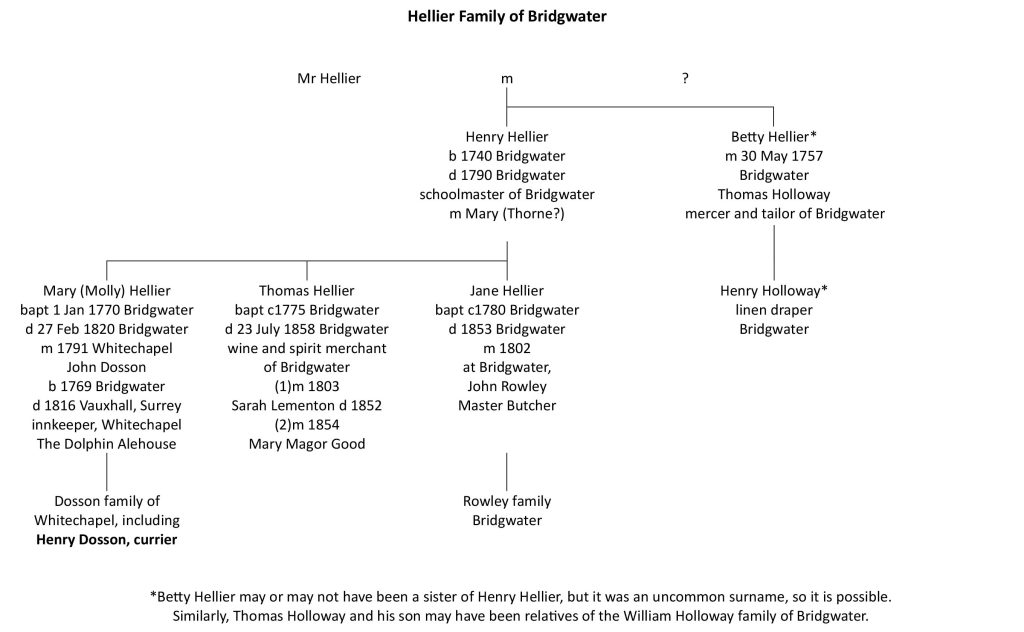
Appendix 2
The Bryant Families of Bridgwater.
Rebecca Bryant (1742-1842) who became the second wife of Thomas Dosson, was probably born in Bridgwater but a record of her baptism has not survived. There are several people with the surname Bryant who were associated in some way with Thomas and Rebecca and who may have been related to her, but equally it may just have been coincidence as Bryant was a common name.
Edward Bryant (1758-1838) is the most likely contender to be a blood relative of Rebecca Bryant as he married in Whitechapel and Thomas Dosson was a witness. Edward was born in Bridgwater, the son of Thomas Bryant and Rebecca nee Goss, but there is no record of a sister named Rebecca. He had an elder bother Thomas Bryant (b 1741) who may have been the Thomas Bryant junior who was a witness when Rebecca and Thomas Dosson married in 1780. He had another brother Josiah Bryant (1750-1804) see below.
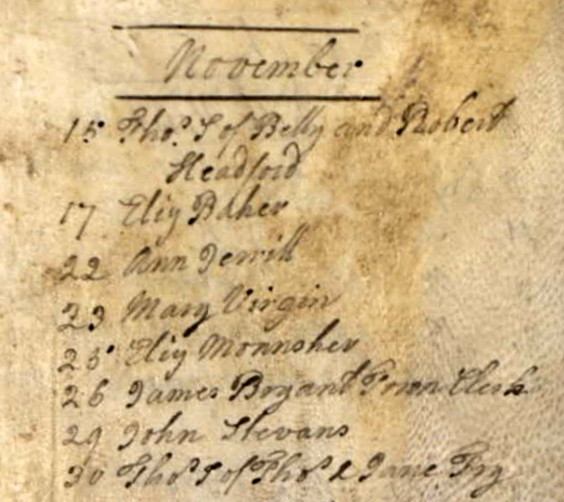
James Bryant, Town Clerk of Bridgwater (d 1771) took the oath as prothonotary and clerk of the peace (town clerk) in the Bridgwater Court of Record on 18 May 1730. This suggests that he was born around 1700 or a little earlier.[33] James is first referred to as prothonotary and town clerk in the court records in October 1737. The last time he was referred to as town clerk was in 1743. John Bryant prothonotary disappears from the records after 1771. During all this time there were many other cases involving James Bryant gentleman or just James Bryant.[34] The 1741 general election was hotly contested in Bridgwater and afterwards there were allegations of corruption. James Bryant, Town Clerk, was involved in defending the election process. A list of Bridgwater voters was published in 1754. [35] It includes:
- Bryant, James, Town Clerk & Capital Burgess
- Bryant, James, Sadler
- Bryant, Robert, a capital Burgess
- Bryant, Thomas, Sadler
- Bryant, Thomas, Butcher
James was buried at St Mary’s Bridgwater on 26 Nov 1771 and ‘town clerk’ is written after his name in the register.
James Bryant (1727-1808) attorney of Bridgwater may have been the son or nephew of an earlier James Bryant, attorney of Bridgwater, who in 1830 paid duty on an apprenticeship. James married Hannah Mills in Burnham-on-sea in 1748 and they had several children baptised at St Mary’s Bridgwater: James in 1749, Susan in 1751, Charles in 1753, Ann in 1755 (probably married John Jarman), Lavinia in 1758, Sarah in 1760 (probably married Reuben Bond) and Robert in 1765. Hannah died and James married Lola Watts (died 1837 Wells) at Wells in 1794. James Bryant junior appears to have become his father’s articled clerk in 1765.
John Bryant (1757-1850) anchorsmith of Wapping. His parents and place of birth are unknown. John married in 1802 at Bridgwater to Sarah Hutchens (born 1775), Rebecca Bryant’s daughter by her first marriage to Thomas Hutchens. The parish register recorded that John was from Wapping, Middlesex, close to Whitechapel. Their witnesses were Susan Hutchens and Sarah’s stepfather, Thomas Dosson. Their eldest child was born in Bridgwater but the younger ones were born in Wapping. John was first recorded as an anchorsmith and ironmonger of Wapping in 1794. Later his sons Richard and Thomas joined him in the family business. In October 1841 there was a flood in Wapping due to blocked sewers. The water was six foot high in the High Street. The water rushed over the wharf of John Bryant the anchorsmith and filling his cellars, was three feet high in his shop and destroyed property to the value of £1000.
Josiah Bryant (1750-1804) currier of Bridgwater and brother of Edward Bryant (above). His son John married Phoebe, daughter of Dosson business associate Capel Tripp. There are no other curriers known that were related to the Dossons and who could have offered Henry an apprenticeship, but Josiah had died before Henry Dosson, currier, was born.
Mary Bryant (1789-1818) was the daughter of Edward Bryant and Dorothy nee Brown of Whitechapel. In 1811, Mary married William Henry Holloway (1785-1871), a wine and spirit merchant, son of William Holloway, a Bridgwater tailor, and Mary nee Bryant. It is not known if the two Mary Bryants were related. Mary and William Henry Holloway had three children all born in Bridgwater. After Mary died in 1818, William and the two surviving children moved to Wapping, London. He married again and moved to Bradford, Yorkshire.
[1] Dosson was an uncommon name in west Somerset and the nearest family appearing in the parish registers was at Bishops Lydeard. About three hundred years after Thomas left, his descendant Leonard John Dosson lived at Stallenge Farm at Bishops Lydeard.
[2] Voters Lists. Bridgwater Blake Museum website.
[3] The Globe Inn was in Eastover in the 19th century.
[4] The General Evening Post. 12 Jan 1758. Google Books.
[5] Index to the Bridgwater Court of Record on the website of the Bridgwater Heritage Group.
[6] The burial of Mrs Mary Dosson, the widow in 1770, has not been found so her age is unknown. Some of the children were baptised at St Mary’s Parish Church, Bridgwater, but not the elder two sons.
[7] Joseph is referred to as a half-brother in the will of his brother Thomas, but as the relevant records of baptisms and burials have not survived, it is not possible to know if Thomas Dosson senior married twice and if so which of the children were from his second marriage.
[8] One notable example in Bridgwater was John Chubb (1746-1818), merchant and amateur artist, who went to stay with an uncle and aunt in Cheapside, City of London. Bridgwater Heritage Group website.
[9] Frederick and Margery Horner had two sons and two daughters, but it is not known how many survived infancy.
[10] The parish register records Thomas Dosson marrying Mary Fisher, not Margery, but this was probably inadvertent. James Fisher’s will referred to “my sister Margery Dosson” and the Whitechapel parish register records the burial of Margery Dosson, 64, in 1779.
[11] The Merchant Taylor’s School still exists, though it is now in Hertfordshire. There were other Dosson families in London and the school admission register only gives the name and the year of admission, however the 1775 London apprenticeship record clearly states that Henry was the son of Thomas Dosson, victualler, Bridgwater. Henry died in 1788.
[12] London Metropolitan Archives MJ/SP/1774/07/008, Middlesex Sessions of the Peace, July 1774.
[13] London Metropolitan Archives MJ/SP/1774/09/074, Middlesex Sessions of the Peace, 8 Sept 1774. Mile End New Town was adjacent to Whitechapel, so this is likely the same Thomas Dosson, even though he is referred to as a yeoman and not a victualler. If he owned land and qualified for jury duty then he was both.
[14] Thomas Dosson identified himself at the beginning of his will as a liveryman of the Vintners’ Company of London.
[15] The families must have remained friends. In the next generation Edward’s daughter Mary married another Bridgwater and London wine and spirit merchant, William Henry Holloway, and their son was an executor for John Dosson.
[16] Freemasons’ records show that Thomas transferred to the lodge in Bridgwater in 1787. The appointment as Constable on 24 Sept 1787 is listed in Borough records. Bridgwater Heritage Group website.
[17] Thomas and Rebecca were to have an annuity of £12 12s. The Friends and Associates of John Chubb. Page 47. Bridgwater Heritage Group website.
[18] 1798 Land tax redemption records, seen on the Ancestry.com website.
[19] Survey book numbers 25 and 26, number 589 on the Town Plan. Borough Records 1835.
[20] British History Online. Bridgwater: Manors and Other Estates. Bridgwater: Manors and other estates | British History Online (british-history.ac.uk) The exact location of Thomas Dosson’s property is not known. George Dosson sold it to Bridgwater merchant William Mogg in 1811.
[21] Reverend Willoughby Stambury (c1734-1782) was the rector of the parish of Stoke Climsland, Cornwall, and the curate of Bawdrip near Bridgwater. Willoughby was living in Bridgwater in 1779 when he wrote his will. In it, he left his home to his four children. His son Henry was still living in Bridgwater until around 1792 when he became the rector of Hinton St George. Borough Records of 1835 list property on survey plan 75 / number on Town Plan 362 in the hands of Thomas Hellier, brandy merchant, as a likely candidate for the property. By then Thomas Hellier was the carer of the widowed Rebecca Dosson. Bridgwater Heritage Group website. 15.jpg (1165×1000) (bridgwaterheritage.com)
[22] The Chubb Collection, Blake Museum Bridgwater.
[23] Electors List 1802. Bridgwater Blake Museum website.
[24] Taunton Courier 18 July 1811
[25] It was demolished in 1828 for the St Katherine Dock improvement.
[26] Thomas Bryant Holloway (c1784-1818), a London surgeon, was the son of William Holloway, tailor of Bridgwater, and Mary nee Bryant. His brother William Henry Holloway was married to another Mary Bryant who was a daughter of Edward Bryant and nee Dorothy Brown.
[27] Shoreditch, Settlement Papers, 1835. London Metropolitan Archives. Seen on Ancestry.com website.
[28] Archibald Brodie (1775-1840) was a victualler in Whitechapel Rd, which is the same address as The Dolphin. He married Maria Sandford in 1798 at St Paul’s Covent Garden. Their two children were Sarah Amelia (born 1811) who married James Peart, and Archibald (1814-1848). Archibald junior was born in Whitechapel and married in 1843 to Margaret Bird (1821-1859) from east London. Margaret’s father was also a licensed victualler. John Miner was sure that the Brodie and Dosson families were related, but a connection has not been found.
[29] No records of daughters named Jane and Ann have been found.
[30] Electors List 1835, 1837 and 1841. Seen on the website of the Bridgwater Blake Museum.
[31] He was an uncle of William Tucker of Clay Hill Farm, Cannington, who has a biography on this website.
[32] 1798 Land tax record.
[33] Report on the Borough of Bridgwater 1835. Bridgwater Heritage Group website.
[34] Bridgwater Heritage Group website. Bridgwater Court of Record index.
[35] Bridgwater in the Later Days by Rev A H Powell, Vicar and Rural Dean of Bridgwater. Page & Son. Bridgwater. 1908. Seen on the website of the Internet Archive.
The 1754 list of voters is online on the Bridgwater Blake Museum website.

